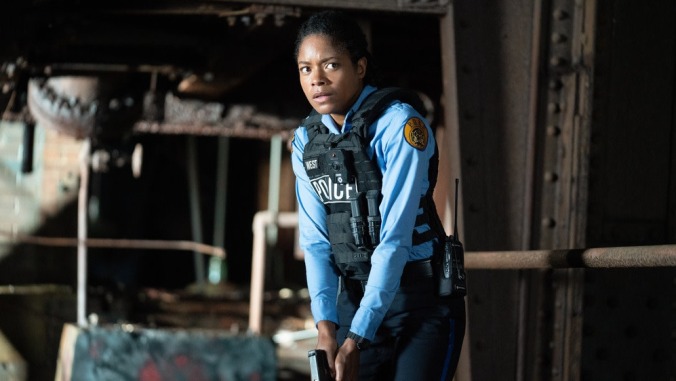It’s good cop vs. bad cops in the generic Black And Blue

Alicia West (Naomie Harris) left her New Orleans neighborhood for the army. Many years later, she’s back on the streets as a cop. And though she’s still only a rookie (it’s her third week on the job), she’s already gotten herself into deep shit. Checking out some noise at a disused factory, she walks right in on the crooked narcotics officer Malone (Frank Grillo) as he executes a couple of drug dealers—one of whom happens to be the favorite nephew of the local gang kingpin, Darius (Mike Colter)—to cover up his own shady business. Now, Malone and his cronies are after West’s body cam, which recorded the whole thing. Of course they’ll kill her to get it. And she’s doesn’t have a gun or a car.
That’s the premise of Deon Taylor’s Black And Blue, a generically competent but unsuspenseful chase film that never lives up to its potential for either social commentary or thrills. Obviously, Taylor (who also directed this year’s The Intruder) and the screenwriter, Peter A. Dowling, have something on their minds. They load up the opening act with nods to the failures and institutionalized racism of American policing, going so far as to have an older Black officer tell West that she has to choose between being, well, Black or blue. Even her nice-guy white partner, Jennings (Reid Scott), doesn’t think twice about walking out of a convenience store in a Black neighborhood without paying. This is not a subtle movie.
Which isn’t to say that a film can’t tackle real social problems while operating in a bold-print, exclamation-mark style; Samuel Fuller, the king of visually pugilistic American B-movies, did it all the time back in the 1950s and ’60s. But any comparison between Black And Blue and the conscientious double-feature entertainments of an earlier era is bound to be unflattering. It doesn’t have that pulp juice, that creative energy that allows a formulaic programmer to transcend its title and tagline. For the most part, it just runs on the plot complications of Dowling’s workmanlike script, which ensure that no one except Colter (better known as Netflix’s Luke Cage) gets to have any fun with their roles, since they’re too busy either incriminating themselves or repeating exposition.
West quickly learns that she has more than Malone and his crew to worry about. Most of the other cops who patrol the area are in cahoots with the bad narc. What’s more, Malone has convinced Darius that it was West who killed his nephew, which means that she now has to contend with heavily armed gangsters in addition to the rotten apples of the NOPD. (Though, to avoid confusion with any real urban police forces based in the extremely tax-break-friendly state of Louisiana, all of their patches read “PDNO.” No cop’s feelings were hurt in the production of this motion picture.) And though West is from the neighborhood, her uniform has made her persona non grata. The only local who is willing to help her (reluctantly, at that) is Milo “Mouse” Jackson (Tyrese Gibson), an acquaintance from way back who now works as a stocker at the aforementioned convenience store.
The goals are simple: avoid Malone, avoid Darius, get the body-cam footage into the right hands, stay alive. But while Black And Blue looks appropriately cold-blooded and professional (it was lensed by Dante Spinotti, the Italian cinematographer best known for his work with Michael Mann), Taylor’s direction never develops a sense of urgency, either for the topical issues at hand or for mechanics of chase and action. Crucially, he fails to establish a set of constraints; we never know how far West has to go to get to safety, and frequent rest stops trip up the pace of the film, which is set over something like a single day. A protracted climax set at night in a blighted housing project (which is introduced to music that sounds suspiciously like the main theme from Sicario) betrays some ambition on Taylor’s part. But like the rest of Black And Blue, it eventually collapses into dull repetition.